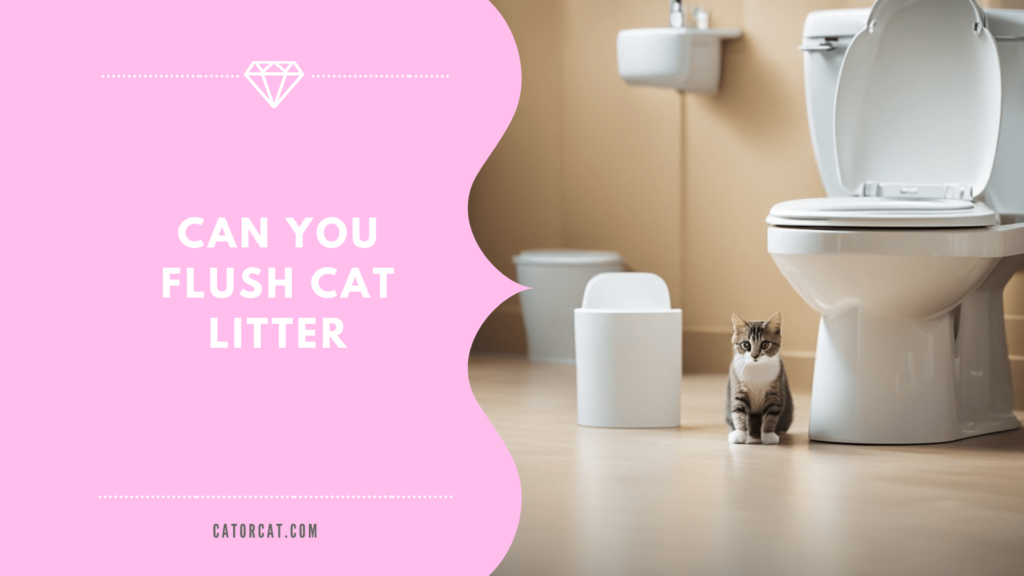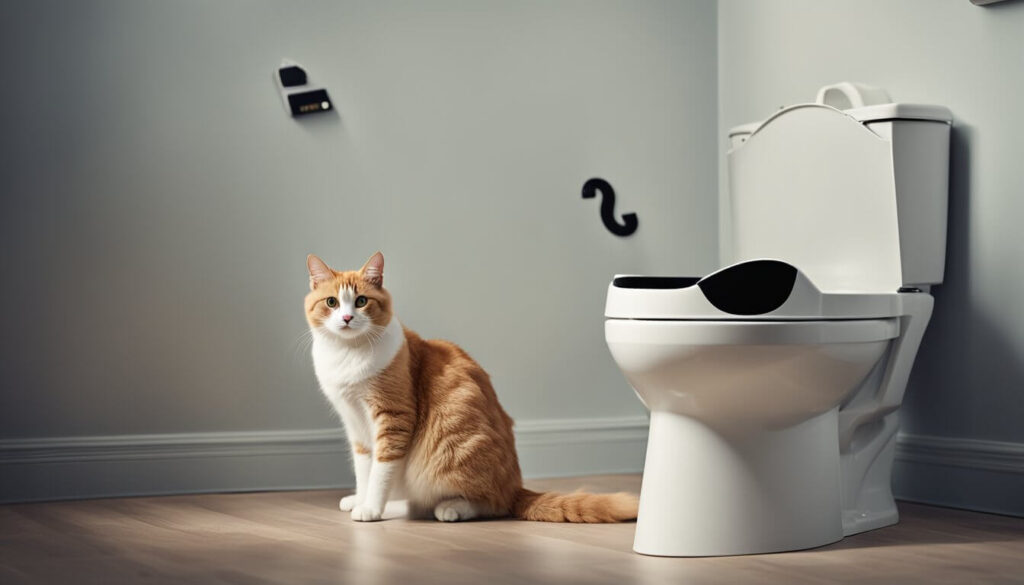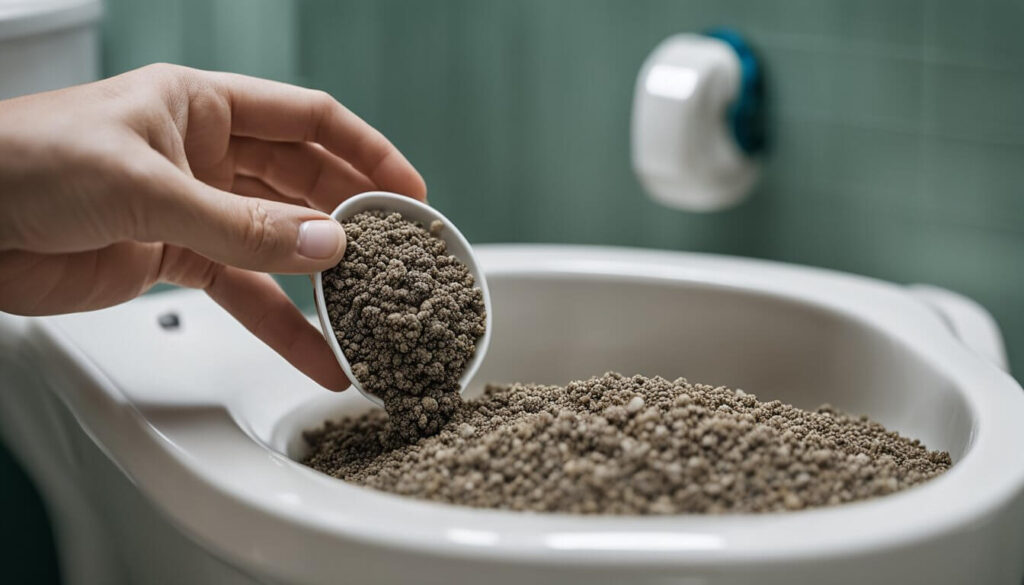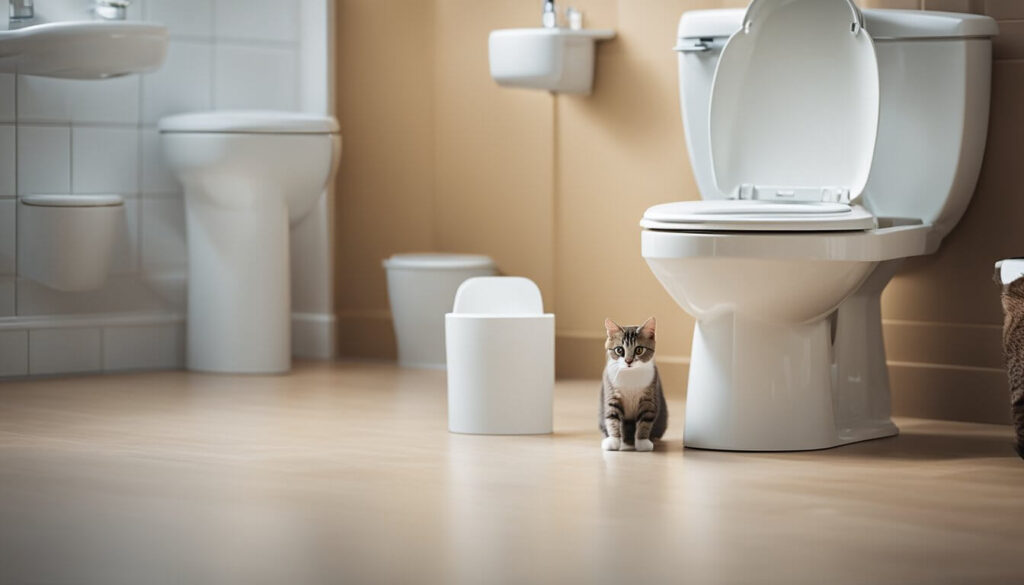
Key Takeaways
- Flushing cat litter may lead to plumbing issues and environmental pollution.
- Health risks could arise due to potential pathogens in cat waste.
- Local regulations may dictate acceptable disposal methods of cat litter.
Most cat owners are familiar with cleaning their cat’s litter box daily. A common question is whether cat litter can be flushed down the toilet. While the idea might offer convenience and immediate disposal, several factors must be considered.
Some litters are marketed as flushable, typically made from biodegradable materials. Yet the ramifications of flushing cat litter, whether biodegradable or clay-based, stretch beyond a simple yes or no.
Review: Kitty Poo club reviews
The impact of flushing cat litter is multifaceted, involving plumbing, environmental concerns, and health issues.
Clumping cat litter made predominantly from bentonite clay, can clog household plumbing and harm septic systems.
Even biodegradable, flushable cat litter, although designed to break down in water, can contribute to blockages and may carry parasites or pathogens into the water system.
Considering local legislation and water treatment capabilities is essential before deciding on disposal methods.
Understanding Cat Litter

Choosing the right cat litter is crucial for the care and hygiene of household cats. To make an informed decision, it’s important to understand the different types of litter available and the materials they’re composed of.
Types of Cat Litter
Clay-Based Litter: The most common type of cat litter is made from clay, specifically bentonite. It’s popular because it forms easy-to-scoop clumps when wet.
- Clumping: This type allows for easy removal of urine and feces, keeping the litter box fresh.
- Non-Clumping: Although less common, some prefer this for its longer-lasting nature.
Review: Pretty Litter – The World’s Smartest Cat Litter
Biodegradable Litters: Made from materials like corn, wheat, pine, or paper, biodegradable litters are environmentally friendly because they break down naturally.
- Corn and Wheat: They are known for their clumping abilities and natural odor control.
- Pine: In pellet form, pine breaks down with liquid and emits a natural scent.
- Paper and Wood: Offering a softer texture, these products are often recycled and less likely to clump.
Silica Gel Litter: Composed of tiny crystals, silica gel litters are highly absorbent and can control odors for extended periods.
Components of Cat Litter
The primary function of cat litter is to absorb waste and control odors. Here’s a breakdown of the components:
- Clay Litter: Comprised mainly of bentonite, it’s known for its high absorbency and clumping properties.
- Biodegradable Litters: Usually made from renewable resources like corn, wheat, sawdust, shredded paper, or wood.
Material Clumping Ability Odor Control Corn Yes High Wheat Yes Moderate Pine No Natural Paper No Low Wood No Moderate - Silica Gel Litter: This litter consists of silica dioxide sand, oxygen, and water. It excels at moisture absorption and odor control without clumping.
Pros and Cons of Flushing Cat Litter

Evaluating whether to flush cat litter involves considering its convenience and the impact on plumbing and the environment. It’s important to differentiate between the types of cat litter available and their specific uses when discussing flushability.
Benefits of Flushable Cat Litter
- Convenience: Flushable cat litter offers a quick and easy way to dispose of cat waste, often requiring a simple toilet flush.
- Environmentally Friendly: Many flushable litters are made from biodegradable materials, making them more eco-friendly than traditional clay-based litters, which take up landfill space.
Drawbacks of Flushing Cat Litter
- Plumbing Concerns: Even some litters labeled as flushable can potentially cause plumbing clogs over time, leading to costly repairs.
- Septic Systems: For households with septic systems, flushing cat litter, even if it’s labeled flushable, can disrupt the delicate balance of the system and may lead to issues with septic tanks.
- Environmental Impact: The risk of toxoplasmosis, a disease transmitted through cat feces, makes it hazardous for local waterways and may harm wildlife, questioning the environmentally friendly label of flushable litters.
Related: How often to change cat litter
Impact on Plumbing and Environment
Flushing cat litter poses significant risks to residential plumbing systems and the broader environment. These effects range from clogging pipes to introducing pollutants into waterways.
Effects on Plumbing Systems
When cat litter is flushed, it can clog pipes and severely damage the plumbing system.
Many types of cat litter clump upon contact with moisture, creating blockages that are challenging to remove without professional assistance.
This problem is not confined to the household but can extend to the municipal water supply, where the buildup of flushed materials can strain the infrastructure.
Septic systems can also be affected, as they are not designed to break down the clay and silica commonly found in cat litter. Complications with septic systems often require costly repairs.
Environmental Considerations
The environmental impact of flushing cat litter is notable.
Many litters contain pollutants that can harm water treatment plants and degrade the quality of waterways.
Substances such as sodium bentonite, a clumping agent found in many litters, do not biodegrade and can accumulate in the environment.
This accumulation poses risks to marine mammals and other wildlife.
The EPA has recognized cat waste as a potential environmental pollutant, advising against flushing it due to the possible presence of toxoplasmosis, which can harm sea otters.
Composting cat litter, if it is made from biodegradable material, is a more eco-friendly alternative to flushing. It reduces the environmental footprint while providing nutrients for non-edible plants.
Health and Safety Concerns

When considering the disposal of cat litter, assessing the potential health and safety risks is critical. Key among these are the dangers of toxoplasmosis and risks to individuals with compromised immune systems, which can arise from improper handling of cat waste.
Toxoplasmosis and Parasitic Infections
Toxoplasma gondii is a parasitic organism commonly found in cat feces.
Transmission of this parasite to humans can occur through the handling of cat litter and can lead to toxoplasmosis, an infection that may cause flu-like symptoms.
The risks are especially significant when cat litter is flushed, potentially contaminating water systems if not treated effectively.
- Transmission: Handling cat waste or flushing cat litter can spread Toxoplasma gondii.
- Symptoms: Infection can result in symptoms ranging from mild flu-like illness to more severe health complications.
Risks to Compromised Immune Systems
Individuals with compromised immune systems are at a higher risk for health issues stemming from exposure to cat waste.
Cat feces can harbor bacteria and parasitic infections that are particularly dangerous for these individuals, potentially leading to more severe health repercussions.
- Increased Vulnerability: Immune systems weakened by illness or treatment (such as chemotherapy) may not effectively fend off infections.
- Exposure Concerns: Ingestion or contact with contaminated material from cat waste—such as urine or feces—can lead to infections that these individuals are less equipped to combat.
Legislation and Regulations
In the United States, the regulations concerning cat litter disposal vary by state, often depending on local sewage systems and environmental considerations. Understanding these laws is crucial for cat owners to ensure they are compliant and environmentally responsible.
State-Specific Regulations
California: California has stringent environmental laws that require residents to follow specific guidelines for waste disposal.
It is generally advised against flushing cat litter in California due to potential harm to marine life and the risk of toxoplasmosis contamination.
Rhode Island: While there may not be explicit state-wide legislation regarding the flushing of cat litter in Rhode Island, local ordinances can impose fines and penalties for improper disposal practices that can affect plumbing and sewage treatment operations.
- Table of Flushable Materials in Selected States:
State Can You Flush Cat Litter? Notes and Restrictions California Generally, no Risk of environmental harm and water contamination; follow local municipal waste disposal guidelines. Rhode Island Consult local regulations Local ordinances to be considered; potential fines for disrupting sewage treatment operations.
Cat owners are encouraged to review their local municipal codes or reach out to waste management authorities to get the most accurate information for their area.
Alternatives to Flushing Cat Litter

When considering alternatives to flushing cat litter, it’s essential to be aware of methods such as disposal in traditional waste systems, composting, and using biodegradable bags. These methods align with responsible pet ownership and environmental conservation principles.
Disposal in Trash
The most common method of disposing of cat litter is in a trash can. However, to prevent spillage and contain odors, the litter should be securely bagged.
Cat litter, especially the non-biodegradable types like clay or silica, should always be thrown away in the trash can rather than flushed to avoid plumbing issues.
Composting Cat Litter
Composting cat litter made from biodegradable materials can be a natural way to recycle waste.
However, only litter made from plant-derived materials such as wood or paper should be added to compost heaps.
It’s crucial to note that compost containing cat waste should not be used on edible plants due to the risk of transmitting harmful bacteria.
Biodegradable Bags for Disposal
Using biodegradable bags to dispose of cat litter is an environmentally friendly option.
These bags are designed to break down faster than traditional plastic when disposed of in a landfill.
Choosing bags made from natural, biodegradable materials minimizes the environmental impact of cat litter disposal.
Best Practices for Cat Litter Disposal
When disposing of cat litter, pet parents should prioritize eco-friendly and simple methods while also considering odor control and the impact on the environment.
Sustainable Disposal Methods
The most common and sustainable method to dispose of used cat litter is to bag it and place it in the trash.
Pet owners should opt for biodegradable bags when available, which contribute significantly to reducing the environmental impact.
This process is convenient for those using scoopable litter, as it allows for easy separation of waste from clean litter.
- Biodegradable Bags: Use to collect clumps before disposal.
- Regular Scooping: Ensures odor control and prolongs litter usability.
Reducing Environmental Impact
Pet owners must acknowledge that not all cat litters are created equal regarding their environmental footprint.
Flushable litter may seem like a water-saving solution. Still, they can compromise the health of aquatic ecosystems and are not suitable for all plumbing systems, especially not for water-saving toilets.
Instead, pet owners can look for eco-friendly litter options that can be composted under the right conditions.
- Eco-Friendly Litter: Look for litter made from plant-based materials.
- Composting: An option for naturally biodegradable cat litter, not for clay or silica-based litter.
Consumer Considerations
When choosing cat litter, consumers need to evaluate their preferences in terms of convenience and the impact on the environment. The type of litter and its disposal method must also align with the well-being of their pets and household needs.
Assessing Litter Box Preferences
The preference for a litter box setup can vary significantly among cat owners.
Some may prioritize clumping litter because of its ease of removal and ability to control odors, yet these types are usually non-biodegradable and are not designed to be flushed.
On the other hand, biodegradable litter, which is often flushable, could be less effective at clustering waste and may require more frequent maintenance.
Cost vs. Eco-Conscious Choices
Flushable litter often comes from sustainable materials like corn, wheat, and sawdust—materials that are kinder to the planet and reduce the effects of strip mining associated with clay cat litter.
However, these eco-friendlier options might come with a higher price tag.
Consumers must balance the convenience and absorbency of traditional litter with the environmental benefits and potential cost increase of biodegradable litter.
Moreover, the latter may also mitigate some concerns over allergens, offering a better option for sensitive individuals and pets.
Frequently Asked Questions
This section addresses common concerns regarding the flushing of cat litter and its effects on plumbing, the environment, and practical flushable alternatives.
1. Is flushing cat poop without litter harmful to plumbing?
Flushing cat poop without litter may still lead to plumbing issues. Solids can accumulate and cause blockages over time.
2. What are the consequences of accidentally flushing cat litter down the toilet?
Accidentally flushing cat litter can lead to pipe clogs and severe blockages that may require professional plumbing services to resolve. Discover why flushing cat litter may harm pipes, environment, and health.
3. Are there any cat litter brands that are designed to be flushable?
There are cat litter products made from biodegradable materials labeled as flushable. However, their impact on plumbing and the environment should still be considered before use.
These types of litter are often made from wood products, corn, wheat, pine, and shredded paper.
4. How does flushing litter clumps affect a septic system?
Flushing litter clumps, even if marketed as flushable, can disrupt the delicate balance of a septic system, leading to backups and potential system failure.
5. What are the environmental risks of flushing cat litter containing toxoplasmosis?
The protozoan parasite Toxoplasma gondii, which causes toxoplasmosis, may be present in cat feces and can contaminate water sources, posing a risk to marine life and public health when litter is flushed.
6. What should I do if I’ve flushed cat litter crystals unintentionally?
If cat litter crystals have been flushed unintentionally, it is advised to monitor for signs of clogging and contact a plumber if any drainage issues arise.
It is best to dispose of cat litter in an environmentally friendly manner to prevent future incidents.
